Godot productivity tips
Thu Oct 12 2023
Updated 16/06/2024
Godot is pretty great to work with—you have a fast, snappy engine with an integrated editor. It has a file size that's smaller than a lot of phone apps and comes with pretty sane defaults!
That said, you can probably squeeze out a bit more performance out of yourself, the developer, in particular, by trying out the following productivity tips.
Quick Open
Quick Open is a nice little dialog that shows a picker of your project files, and on pressing Enter, it opens it in the scene or script editor, respectively. By default, it's bound to "Shift+Alt+O". I personally rebounded it to the de-facto standard shortcut for file pickers, "Ctrl+P." What's great is that it works with an external editor as well!
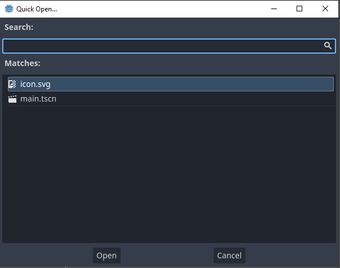
One strange thing about its behavior is that it will open the script editor if you pick a script while in the 2D/3D editor, but it won't open the 2D/3D editor if you pick a scene while you are in the script editor. I guess it's because it doesn't look at the root node of the scene file to determine if it should open the 2D or 3D editor.
Quick Run Scene
So, you are working on a scene that isn't the default scene, so you set it in the project settings as the main scene, but then you accidentally commit it to git, and then other teammates start giving you shit about it, so you start using Run Current Scene (F6), but quickly realize that having to select that scene every time you want to run it is kinda inconvenient.
"Quick Run Scene" has your back! By default, it's bound on Ctrl+Shift+F5 (at the time of writing, in the editor shortcuts it is listed as "Run Specific Scene"), but I have it bound on F5 as it's my go-to way of running scenes. If you don't close the game screen, you won't have to retype the name of the scene again; it will just relaunch the last one! Allows you to iterate quickly!
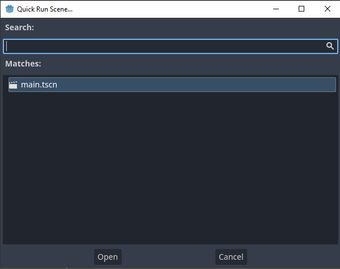
Unique names
If you are like me, you are using $SomePath, or get_node("SomePath") to store references to the nodes you need. Then you move nodes into a container, everything breaks, and you have to adjust the paths. Frustrating. There is a better way, though: unique nodes.
You mark a node as unique by right-clicking it and then pressing "Access as Unique Name."
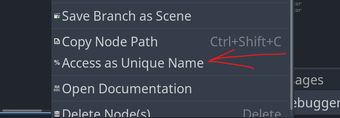
As you can see, a percentage symbol appears next to it. After that is done, you can just reference it with a % prefix, like this:
# assuming your node is called "SomeImportantChildNode"
@onready var some_important_node = get_node("%SomeImportantChildNode")These names are local to the scene, so in other scene files, you can freely reuse the "SomeImportantChildNode" name as unique. Unique nodes, just like regular nodes, can also reuse the same name as long as they are not siblings in the hierarchy, but you can't have two unique nodes with the same name within the same scene:

In terms of the "tscn" file, it just adds the unique_name_in_owner = true to the node data, nothing magical. But now, you can freely move it around in your scene tree, and some_important_node will keep pointing to the same thing, and there's no path that needs updating!
Inherit selectively
Imagine you create a new scene; the top node is a HBoxContainer. You need to do more things with it than the inspector lets you, so you attach a script to it. By default, its top line will say extends HBoxContainer. All is well, but suddenly you decide that you want to align the children vertically, so you change the type of your HBoxContainer to a VBoxContainer. You run the scene, and Godot crashes.
Script inherits from native type "HBoxContainer", so it can't be assigned to an object of type: "VBoxContainer".
So you go into your script, change the top line to extends VBoxContainer, and work continues. After a while, you change the type back to a HBoxContainer, because, you know, iteration and stuff. Now you have to go back into your script and change the top line again. In time, you realize you aren't using the methods of the HBoxContainer. Hell, the HBoxContainer doesn't even have methods.
What's the solution, then? You extend higher up the inheritance hierarchy. In simpler words, you pick a class that HBoxContainer inherits from, e.g., Container, Control, or CanvasItem (you can see the inheritance hierarchy at the top of every node documentation page), depending on what functionality you need in your script. In even simpler words, extend Control if you attach a script to a user interface item (like a container), extend Node if you don't need to do anything more than add_child() in your script. I hope you get the gist.
If you're wondering, that won't impact the node itself. The inspector's properties for the node won't change, its behavior won't change, etc.
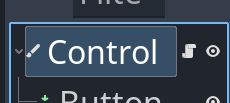
Of course, if your node is, let's say, a Label and you need to change the text property, you need extends from Label; otherwise, accessing text will give you an error.
In the end, this is purely situational, but it is good to know nonetheless. The more you use Godot, the more you'll start to remember these inheritance hierarchies, and then you'll be able to decide if you actually need to extend your script from the exact type of your node or if you can just use some of its parent classes.
Create a setup script for new projects
If you are like me and you create new Godot projects regularly, you can use a setup script to quickly set up project settings in a new project. I describe the process in the article "Godot project configuration with GDScript".
QWER
Q, W, E, and R are the keyboard shortcuts for select, move, rotate, and scale, respectively. You can use these to quickly change the cursor modes in the 2D and 3D workspaces, which is really convenient when you are working with canvas items a lot, like when doing world design. I checked, and these shortcuts are the same as in Unity 3D too, which I felt was important to mention for some reason.

Also, you can probably boil down this entry to "learn keyboard shortcuts". So here's some more, which I use on a daily basis:
- "F2": rename node. Personally, though, I changed that to Ctrl+R because of nasty Ableton habits and later realized that it made it quite convenient for copying the node name for unique name usage—just Ctrl+R Ctrl+C.
- "Ctrl+Shift+C": copy the file path in the "FileSystem" dock. Copy the node path when in the "Scene" dock. Copy property path when a property is selected in the "Inspector" dock, and probably some more usages I don't know about yet myself.
- "Ctrl+A" and "Ctrl+Shift+A": Add Node and Instantiate Child Scene, respectively.
I personally don't use the built-in script editor (<insert vim flex>), but @dbat hooked me up with some useful protips for it:
- "Ctrl+L": go to a specific line number.
- "Ctrl+Shift+F" and "Ctrl+Shift+R": Finds (and replaces) across all files (you can specify a directory, etc.). The results will be shown in a nice panel, which will lead you to the correct file and line number.
- this is a common IDE shortcut, so it will be familiar to lots of people. Holding down Ctrl while clicking on variables and functions will (when it works - dbat's words, not mine, lol) take you to the definitions in the code and finally to the docs.
- "Ctrl+" toggles the panel of opened scripts and the documentation on the left. That panel also has an outline for the current file, which is handy if you need to get to a specific method.
- "Alt+F1" will go to help on the selected thing. Pressing just "F1" will open a nice help filter.
- Double-clicking on words while holding Alt selects them and places multiple cursors. You can also create multiple cursors with "Ctrl+Shift+up/down arrows". Go back to a single cursor with Esc.
- "Ctrl+F" and "Ctrl+R" to find or replace in the file. Enable "Selection Only" to limit the region of potential replacements.
- The context menu (right-click) for scripts has some useful stuff like "Show in FileSystem."
Also, dbat recommends, and I agree, that you should have "Trim Trailing Whitespace on Save" turned on (Editor Settings → Text Editor → Behavior), especially if you use git and want to have diffs that are easier to read.
There are shortcuts for lots of things, and everyone should be able to find some to speed up their workflow. With that, I hope that the Godot developers add even more over time (or just actions that can be bound to keyboard shortcuts), e.g., one for attaching scripts, which is an action I use constantly.
Quick node references
If you hold Ctrl while you drag a node from the node tree into the code editor, Godot will generate a variable with the reference for you:

Blender style transforms
If, unlike me, you are familiar with Blender, you can enable Blender-style transforms in the spatial editor, like:
g2.5xx: Translate 2.5 units along the local x-axisry-45: Rotate -45 degrees around the y-axiss.25Z: Scale by a factor of .25 on the xy plane
Keep in mind that you have to assign keybinds to them first because they are not bound by default. Just go to Editor → Editor Settings → Shortcuts and type "begin" in the filter bar:
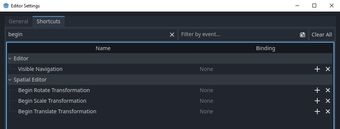
And the results:
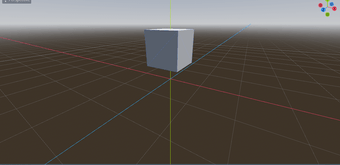
Editor layout
Last but not least, and somewhat obvious, I still wanted to include it for completeness sake.
Find some time to create an editor layout that works for you.
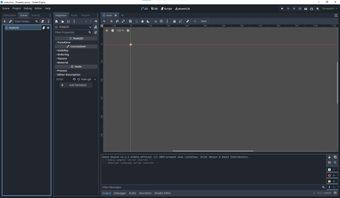
Identify the actions which you do the most and create a layout which serves them best. I am mostly doing game logic, game backends, those kinds of things, so my layout is tailored to that. Artists might have a different layout, generalists might have a different layout, depending on their current focus.
Conclusion
I hope these will help you get more done in less time, or that at the very least you learned something new! I will add more tips to this article over time, as Godot is in active development and cool new stuff gets added all the time. If you have any advice of your own, comments, or criticisms, let me know in the socials!